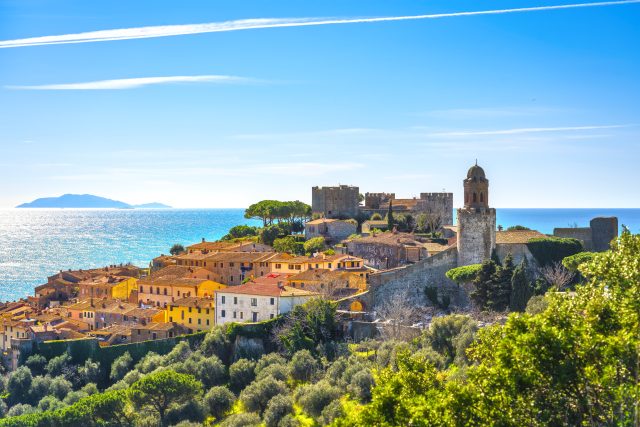If we had to back one Italian wine region to become a firm fixture in cellars in the next few years, it would be coastal Tuscan sub-region Maremma. Sarah Neish reports.

Tongues have been wagging about Maremma, a corner of southern Tuscany with 160km of unspoiled coastline nudging up to the Tyrrhenian Sea. Claims have been made that it is both Italy’s answer to Provence in terms of becoming a mecca for premium rosé, and judging by the slew of medals it has picked up in db‘s Global Masters competitions, also has increasing potential for fine reds and whites.
Speaking to db, Alessandro Comitini, Italy brand manager for London-based importer Armit Wines, says Maremma’s secret lies in its ability “to combine coastal influence with altitude, producing wines with both a strong Mediterranean profile and superb elegance.”
According to Comitini, Maremma has long been a playground for creative winemakers wanting to break free of the constraints imposed by other appellations. This is due to the expanse and diversity of its terroir as well as a large number of permitted grape varieties, giving winemakers an expansive toolbox to choose from.
“The Maremma has a lot of land to farm, and its proximity to the coast, higher slopes and protective forests all combine to create a fantastic environment for vines to thrive,” Comitini explains. “There are also many more grape varieties (87 in total) available to use compared to other Italian regions. This exciting combination offers winemakers more freedom to develop unique styles which express the exceptional terroir.”
Rosé mecca
One category in which Maremma excels is rosé (rosato) production, with Lamberto Frescobaldi telling db he believes the region could become Italy’s equivalent to Provence for fine pink wines. Frescobaldi, who owns Tenuta Ammiraglia in the region, explains that “the Maremma Vermentino train is already running fast” and that rosé is primed “to jump on it”.
“The abundance of sunlight, paired with the sea air, gives us ideal conditions for producing elegant wines full of generous aromatics,” he says, adding “there is something truly unique about this place.”
But does Maremma have the infrastructure to become the sort of cultural icon destination that Provence has established?
“Yes, absolutely,” says Alexandra Hale, head of marketing and communications for Armit Wines, which currently stocks 11 wines from the region. “Maremma is a desirable coastal destination and (as with the whole of Tuscany) offers great accommodation options, easy accessibility from a range of airports, and stunning weather for much of the year, not to mention the outstanding wine and food options. It has all the essential attributes of an ideal tourist destination.”
Hale highlights The Belle Vite as one example of Maremma producers upping their wine tourism game. Others include Fattoria Le Pupille, housed in an antique farmhouse, and Petrolo, which has a range of villas for guests to stay in.
As for the rosé wines themselves, Comitini says it will be “fascinating to see their evolution.” Maremma rosé is “a touch more full-bodied than most Provencal styles, however it lends itself beautifully to food, whilst still being elegant and refreshing, so there is huge potential there.”
Every price point
A big advantage of the Maremma is that wines span every price point, meaning the region has potential to become both a household name and a firm fixture on the secondary market.
“One of the great opportunities that the Maremma offers is the broad array of price points covered. Wines range from accessible to collectable, offering something for everyone,” says Hale.
The Mongrana Maremma Toscana 2022 from Querciabella, for example, a blend of Sangiovese, Merlot, and Cabernet Sauvignon, is priced at about £20.79 a bottle with Armit, perfect for a weeknight dinner at home. Meanwhile, the same producer’s “white Super-Tuscan” Batàr, a barrel-fermented Pinot Bianco/Chardonnay blend, is currently priced at £81 a bottle at Fortnum & Mason, and is known for its cellaring potential.
The Aurea Gran Rosè 2023 from Frescobaldi’s Ammiraglia estate retails for about £40, towards the mid-to-top end of the rosè market (Chateau d’Esclans’ Whispering Angel goes for about £20 in the multiples, while Gerard Betrand’s Clos du Temple 2021 is selling for £230 a bottle at Hedonism).
Medal winners
Then there’s Zonin1821’s Rocca di Montemassi Sassabruna 2022, a red blend of Cabernet Sauvignon, Petit Verdot and Syrah, which retails for approximately £55. It picked up a silver medal in this year’s Organic & Vegan Masters competition, with Patrick Schmitt MW describing this wine as having “instant appeal” with “fleshy red cherry and stewed blackberry fruit, then toast and cedar wood notes from barrel ageing, followed by firm, fine, dry tannins on the finish, that bring a refreshing edge to a powerful wine with many layers of delicious and complementary flavours.”
Better still, the producer’s eponymous Rocca di Montemassi Le Focaie wine scored a gold medal in the same competition, evidencing the quality coming out of Maremma at the moment.
Growth potential
Armit believes the Maremma has strong potential for growth in the coming years.
“We have been listing wines from the region since 1998 and are really looking forward to watching Maremma evolve as more people discover the diverse and appealing styles on offer,” says Hale.
And with Tuscany being one of the two best-selling Italian fine wine regions in the last 12 months, enthusiasts will doubtlessly be intrigued to learn more about its coastal progeny.
Related news
Don’t miss db’s Italy Report 2025, out now
Breakthrough in Italy’s de-alcoholised wine ‘deadlock’
Seven talking points from Vinitaly 2025 (apart from tariffs)

